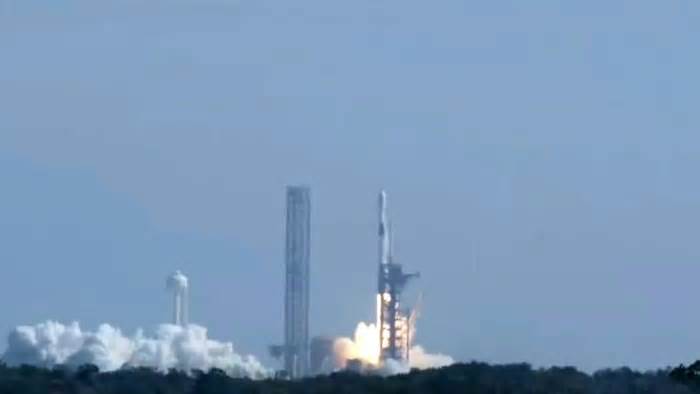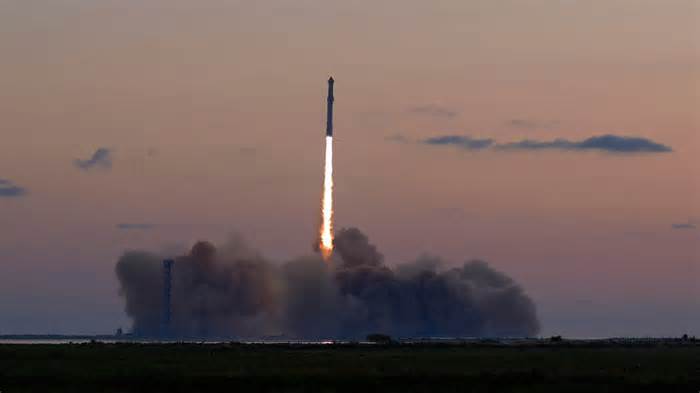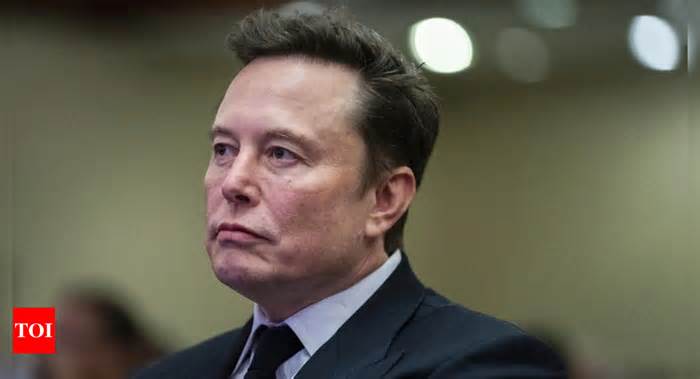
Expending the Expendables: More launch companies are betting their future on reusability
- by SpaceNews
- Nov 11, 2024
- 0 Comments
- 0 Likes Flag 0 Of 5

A timelapse photo showing the successful Oct. 13 landing of the SpaceX super heavy booster. Credit: SpaceX
Almost no one thought SpaceX would make the catch, at least not on the first try.
On the fifth integrated test flight of Starship, launched Oct. 13 from the company’s Boca Chica, Texas, site, the Super Heavy booster aimed to fly back to the launch tower, where massive mechanical arms — dubbed “chopsticks” — would grapple it. So many things could go wrong that most expected failure, much like SpaceX’s early attempts to land Falcon 9 boosters a decade ago.
Inside the company, though, there was confidence. At a National Academies committee meeting just four days before the launch, Bill Gerstenmaier, SpaceX’s vice president of build and flight reliability, noted that on the previous test flight in June, the Super Heavy booster “landed” with pinpoint accuracy — within half a centimeter of a target in the Gulf of Mexico. “So, we think we have a reasonable chance to go back to the tower.”
That confidence was justified. On the Oct. 13 flight, the Super Heavy booster flew back to the same launch tower it lifted off from just minutes earlier. The chopsticks moved into position, cradling the booster. The catch worked.
That achievement is critical to SpaceX’s plans to rapidly reuse Starship. In the company’s long-term vision, Super Heavy boosters will return to the launch pad, and have a new Starship upper stage attached, and be ready for the next launch just days — or even hours — later.
The success of that catch illustrates the future of space access: not just SpaceX’s unique approach with Starship, but a broader vision of vehicles reused rapidly and frequently. SpaceX is already proving this with Falcon 9, whose boosters have been reused more than 20 times, but Starship aims to push reusability even further. Other companies and countries are realizing that to keep pace with SpaceX, they too must embrace reusability, and fast.
“Reusability is mandatory”
At recent conferences from Milan to Mountain View, leaders of space agencies and companies have made it clear that the future of space access won’t rely on expendable launch vehicles but on those that are at least partially reusable.
“I think all of you realize that reusability is mandatory for launchers,” said S. Somanath, chairman of the Indian space agency ISRO, during a head-of-agencies plenary at the International Astronautical Congress (IAC) in Milan, held the day after the latest Starship flight.
He explained that the push for reusability is driven by the need to lower launch costs. “Access to space has to be affordable for us to expand the space program.”
His comments came a month after the Indian government formally approved ISRO’s Next Generation Launch Vehicle (NGLV) project to develop a reusable rocket. Designed to carry up to 30 tons to low Earth orbit — three times the capacity of India’s largest current rocket, the LVM3 — it will do so at a cost just 50% higher than LVM3.
That cost savings will come from a reusable booster with a throttlable engine using liquid oxygen and methane propellants to enable powered landings, he said. Engine development will drive the NGLV schedule, with a first test flight projected in about six years.
The following week, at the Satellite Innovation conference in Mountain View, California, an industry executive echoed this view on the importance of reusability.
“If you don’t have a reusable launch vehicle, I don’t think you have a future as a launch company,” said Adam Spice, chief financial officer of Rocket Lab, speaking on a panel with other launch executives. “Expendable rockets really don’t have a path.”
Rocket Lab has experimented with reusability on its Electron rocket, recovering stages and testing them. While it has yet to refly a full Electron booster, it did reuse an engine. Reusability, however, is central to the company’s larger Neutron rocket, with a first launch projected in 2025.
Others are following similar paths, developing reusable first stages like the Falcon 9. Among them is Blue Origin, with its much larger New Glenn rocket, slated for an inaugural launch by year’s end. The company aims to land the first stage on a ship in the ocean on the first try.
“No one has landed a reusable booster on the first try. Yet, we’re going for it, and humbly submit having good confidence in landing it,” Dave Limp, chief executive of Blue Origin, said in a September social media post unveiling the name of the first New Glenn booster: “So You’re Telling Me There’s a Chance.”
“For this first launch, I have two primary objectives: get to orbit and land the booster,” said Jarrett Jones, senior vice president for New Glenn at Blue Origin, during a World Space Business Week panel in mid-September. “It’s super-critical because we have to get that down pat and then get our reusability and then get to rate. We can’t wait on it in 2025.”
The New Glenn first stage en route to Cape Canaveral Launch Complex 36, carried atop a repurposed U.S. Army tank transporter. Credit: Blue Origin
Stoke Space is going a step further, designing a two-stage vehicle where both stages are intended to be reused, similar to SpaceX’s ultimate vision for Starship.
“If you look at the flight rate limiter for SpaceX,” said Devon Papandrew, Stoke’s vice president of business development, “it’s production of the second stage.” While SpaceX can reuse the Falcon 9 booster 20 or more times, each launch still requires a new second stage.
“Our thesis — or at least one of the ways that you can compete with SpaceX in the long run — is full reusability,” he said on the Satellite Innovation panel. This approach shifts space transportation from high manufacturing demands to challenges of operations and logistics. “You’re getting your entire vehicle back, refitting it, refurbishing it, refueling it, and flying it again.”
European reusability dreams
In Europe, the reaction to Starship was mixed. Josef Aschbacher, director general of the European Space Agency, acknowledged at IAC the technical achievement of the latest Starship test flight, stating, “I then have to think, what does it mean for Europe, and to see what would be the change in the landscape and the ecosystem, and what do we need to do.”
Some in Europe’s space industry view Starship as a sign of how far behind they are compared to SpaceX. Rocket Factory Augsburg, a German developer of small launch vehicles, stated the day after Starship’s flight, “It shows and confirms that Europe has completely lost touch. Can it still catch up? No chance. At least not the way things are going at the moment.”
Critics note that Europe’s Ariane 6 was developed before SpaceX demonstrated the feasibility and benefits of reusability, and there are no plans to retrofit the rocket for reuse. However, private efforts in Europe are emerging to develop reusable launchers. For instance, MaiaSpace, a startup spun out of ArianeGroup, is working on a small launch vehicle with a booster designed for vertical landing and reuse, similar to SpaceX’s Falcon 9.
Another European company with grander reusability ambitions is PLD Space. At an Oct. 7 event marking the first anniversary of its Miura 1 suborbital launch, the Spanish startup outlined a decade-long roadmap of vehicle projects, beginning with its Miura 5 small launch vehicle.
PLD Space aims to recover and reuse Miura 5’s first stage. Initially, the company considered parachutes and an ocean splashdown — the same approach Rocket Lab has pursued with its Electron — but now plans to pursue propulsive landings similar to those of Falcon 9.
“If you see an airplane from Boeing or an airplane from Airbus, the way of landing is the same,” Raúl Torres, chief executive of PLD Space, said in an interview. “We reached the conclusion that the only way to make a stage reusable is bringing it back in the same fashion that SpaceX or Blue Origin is doing.”
PLD Space’s Miura Next Super Heavy rocket would feature four side boosters making simultaneous landings back at the launch site. Credit: PLD Space
Miura 5 is scheduled to begin launches in 2025 from French Guiana, with reusability to be gradually incorporated, flying reused boosters no earlier than 2028. PLD Space projects that reusability will double the profitability of the rocket but did not disclose the impact on payload performance.
PLD Space plans to extend reusability to a line of larger rockets called Miura Next. The baseline model would be a medium-class rocket with a booster capable of landing back at the launch site or on a downrange ship. One variant, Miura Next Heavy, will add two, similar to Falcon Heavy, while the Miura Next Super Heavy will include two more.
While the Miura Next vehicles can fly in expendable mode to maximize its payload capacity, the company plans to recover the booster on most missions, with the side boosters returning to the launch site. At its event, PLD Space presented an animation showing four side boosters from a Miura Next Super Heavy rocket making simultaneous landings.
Reusability, Torres said, is essential to the company’s goals for both environmental sustainability and cost reduction. “If we can’t bring it back,” he said, pointing to an image of the four simultaneous landings, “this image is just a dream.”
ULA gets SMART
United Launch Alliance has adopted a different approach to reusability. The company contends that its Vulcan rocket’s design — a “high-energy” booster that flies most of the way to orbit before stage separation — makes it infeasible to land it. Instead, it offered an alternative called Sensible Modular Autonomous Return Technology (SMART), which would recover only the engine section for reuse. That would be more technically feasible, it argued, while recovering the most valuable part of the booster.
As it worked on getting Vulcan to the launch pad, the company did not emphasize SMART reuse much. With Vulcan finally flying, however, ULA is spending more time talking about its plans to recover and reuse the engine section of the Vulcan booster.
In a briefing before Vulcan’s Oct. 4 Cert-2 launch, ULA CEO Tory Bruno reported progress on SMART reuse, including a preliminary design review of the system early in the year. A key element of the project is an inflatable heat shield designed to decelerate the engine section from hypersonic speeds post-separation. This technology builds upon NASA’s Low-Earth Orbit Flight Test of an Inflatable Decelerator (LOFTID), which successfully demonstrated a smaller-scale version during a November 2022 Atlas launch.
Bruno said ULA is on track to complete a critical design review of the recovery system by the end of the year. “Then we start manufacturing flight hardware,” he said. “There’s still more testing of that actual flight hardware before we fly it, but we would be probably, I would say, another one to two years away from the first flight.”
He said the company would take an incremental approach to engine recovery and reuse. The first test on ensuring the engine section can cleanly separate from the booster. Only then will ULA test the inflatable decelerator, which Bruno noted would also serve as an “excellent raft” after a parachute-aided splashdown. ULA will collaborate with Blue Origin to examine the recovered BE-4 engines, though they won’t be reused immediately.
“We may do that a couple of times until we feel really comfortable,” he said of those recovery tests, before reusing the engines. Eventually he said the company will do the engine refurbishment and reinstallation work at Cape Canaveral. “That’s a ways down the road, and I don’t know exactly when that will happen.”
Reduced reuse
While the launch industry is rapidly trending toward at least partial reuse, not everyone is on the reusability bandwagon just yet.
“I don’t think reusability per se will equal survival,” said Giulio Ranzo, chief executive of Italian launch vehicle company Avio, at the Satellite Innovation conference. His company makes the Vega C, a small solid-fuel rocket, with no plans to incorporate reusability.
He argued that a key factor driving reusability is the high launch cadence it enables. For SpaceX, he noted, this is critical because of its large customer base in the U.S. government and its own Starlink constellation. “If you live in a part of the world with no such anchor customer, I don’t know what you are going to do that cadence,” he said.
He noted Avio is developing technologies — such as a rocket engine using liquid oxygen and methane propellants — that could support future reusable vehicles. “I think that cadence needs to be rightsized to the size of the market that you can actually reach,” he said, “otherwise, you’re going to do pretty much nothing with it.”
Rocket Lab initially pursued reusability to boost Electron’s launch rate without expanding its factory. However, demand has not met expectations: the company once projected 22 Electron launches this year but had only completed 11 through October.
“We’re still working on the timing of introducing the reusable booster,” said Spice, Rocket Lab’s chief financial officer regarding the company’s plans for Electron. He added that the company is prioritizing work on Neutron.
Reusability can even take a back seat at SpaceX. The day after the Starship test flight, the company launched a Falcon Heavy rocket carrying NASA’s Europa Clipper mission. The demands of that Jupiter-bound spacecraft meant that SpaceX expended all three booster cores on that Falcon Heavy rocket to maximize performance. That, however, has increasingly become the exception to the rule.
This article first appeared in the November 2024 issue of SpaceNews Magazine.
Related
Please first to comment
Related Post
Stay Connected
Tweets by elonmuskTo get the latest tweets please make sure you are logged in on X on this browser.
Sponsored
Popular Post
Tesla: Buy This Dip, Energy Growth And Margin Recovery Are Vastly Underappreciated
28 ViewsJul 29 ,2024






 Energy
Energy



















